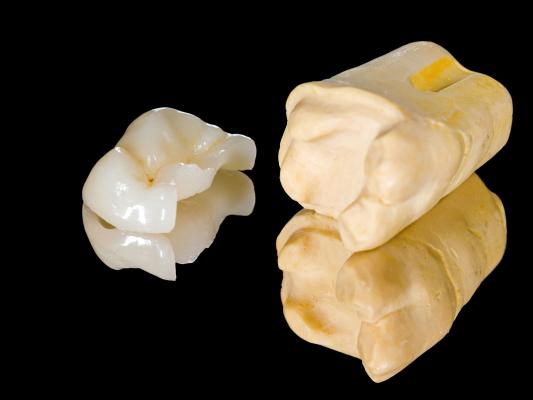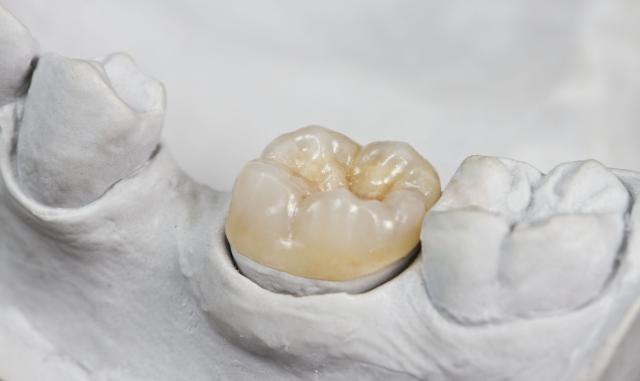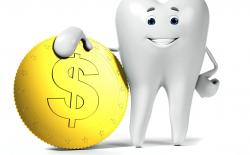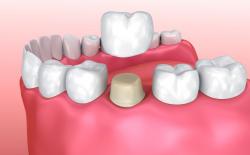How are partial crowns categorized?
Dental crowns are widely used after certain dental treatments like implant restorations or root canal treatments, to help the remaining tooth structure by supporting and maintaining its integrity.
They might be a treatment option for esthetics and functional purposes.
Based on the coverage of the tooth portion, they can be classified as full dental crowns and partial crowns.
Dental crowns can be categorized based on the material they are made of:
- all-metal crowns and gold crowns
- all-ceramic crowns (e.g. zirconia, E-max, Lava)
- porcelain crowns
- porcelain fused to metal crowns
Partial crowns are further categorized based on the coverage of the tooth:
- three quarter crown
- reverse 3/4th crown
- seven eighth crown
- one half crown
- conservative crowns
A great video about the full and partial crown procedures. Duration: 2:59.
What is a three-quarter crown?
Three-quarter crown (or 3/4 dental crown): As the name suggests this type of crown covers approximately the three-fourth (75%) area of the tooth. It covers the roof and 3 walls of the tooth leaving the labial wall (outer wall) intact.
Reverse three-quarter crown: This crown is commonly used in lower rear teeth. It is the same as three fourth crowns, covering 3 walls and the occlusal (roof) surface but it leaves the lingual/palatal (inner) wall intact, that is why it is called the reverse three-fourth crown.
What are the other types of partial crowns?
Seven-eighth crown: This type of crown is the extension of the three-quarter crown covering the three walls and the roof along with the major portion of the outer wall. So it covers almost the entire surface of the tooth.
One-half dental crown: This is also like a three-quarter crown, but the distal wall of the tooth (the wall which is away from the midline contacting the rear tooth) is preserved.
Conservative crown: This includes laminates that only cover the outer/labial (visible when you smile) surface of the tooth. Laminates are used in front teeth. It is exclusively used for esthetic purposes to cover gaps or spaces between the teeth, to get lighter shade for heavily stained teeth, etc.
A ceramic inlay that doesn't cover the entire surface of the tooth.

What materials are inlays and onlay made of?
Partial crowns are made up of metal, metal ceramic, porcelain, etc, the same materials as full crowns.
The material chosen depends on the purpose of placement. Only laminates are made up of porcelain and they are not available in metals as they are primarily placed for esthetic purposes.
The most common type for a front tooth is zirconia or e-max. You can also get a same-day Cerec crown if your dentist has the appropriate CAD/CAM device to manufacture it in the office.
Metal crowns (e.g. gold) or porcelain fused to metal ones are more common in the molar area.
The type of partial crown selection depends on the tooth on which it is to be placed, tooth angulation, etc.
When do you need a partial crown instead of a full crown?
Inlays and onlays are indicated only when your tooth structure is healthy, free from caries, firm, and strong enough to provide sufficient surface area for a better grip and retention of the partial crown when glued.
If there is a possibility of periodontal problems or any gum disease or cavities, it is always better to get a full crown as it protects the remaining tooth structure.
The best advantage of a partial crown is that a relatively small amount of trimming of the tooth is required as compared to full crowns.
How much do partial crowns cost?
The cost of partial crowns is nearly the same for almost all types. It depends on the material used for fabrication, the dentist's charges, and various other factors.
Prices may vary slightly depending on systems like E-max, Cerec, In-ceram, etc.
Partial metal (stainless steel) and metal-ceramic partial (stainless steel with ceramic) crowns are comparatively less expensive than porcelain/ceramic partial crowns.
Here is a rough estimate of the average prices in various countries:
Ceramic inlays / onlays:
- United States: $800 - $1500
- United Kingdom: £500 - £800
- Canada: $500 - $1700
- Austtralia: $500 - $1700
Metal inlays / onlays:
- United States: $700 - $1200
- United Kingdom: £250 - £400
- Canada: $800 - $1200
- Austtralia: $700 - $1500
As usual, metal crowns are a bit more affordable than ceramic crowns (except for gold, which costs about as much as ceramic crowns).
Need a local dentist?
A large onlay on a molar tooth. This is how crowns and onlays are made in dental labs.

Frequenlty asked questions
Is it painful to get a partial crown?
Little sensitivity might be seen after the crown preparation or trimming. It usually becomes comfortable within a week of crown placement.
My partial crown fell out, what should I do?
Preserve your crown and visit your dentist as soon as possible. The dentist will look out for cavities and will try to fit the crown again. If everything is well and good, the same crown can be glued again, otherwise, it is mandatory to place a new crown.
My partial crown became loose, what should I do?
Please ask for an appointment with your dentist. Loose crowns should be checked as soon as possible to avoid further complications. The most common cause of this is decay under the crown, but the exact reason should be checked by your dentist.
How long do partial crowns last?
If properly maintained with good oral hygiene and care, they last for 7-8 years and may even extend up to 10 years or more. Gold is especially durable, however, patients don't really like it because of its low esthetics.
Which one is better: full or partial crown?
Both crowns have their own advantages, disadvantages, and indications. So, it depends on a number of different factors, which can only be discussed after a clinical assessment by your dentist.
You might also be interested in:
Dental Crowns Cost
The price of a dental crown depends on many factors. Read our article to find out more about what affects the cost of a dental crown.
How Long Do Dental Crowns Last?
While the average lifetime of a crown is 5-15 years, many crowns last a lot longer than that. Learn more about the most important factors that determine the longevity of a dental crown!
Dental Crown Pain
Secondary caries, infection, and loose crowns are some of the most common reasons for dental crown pain.


